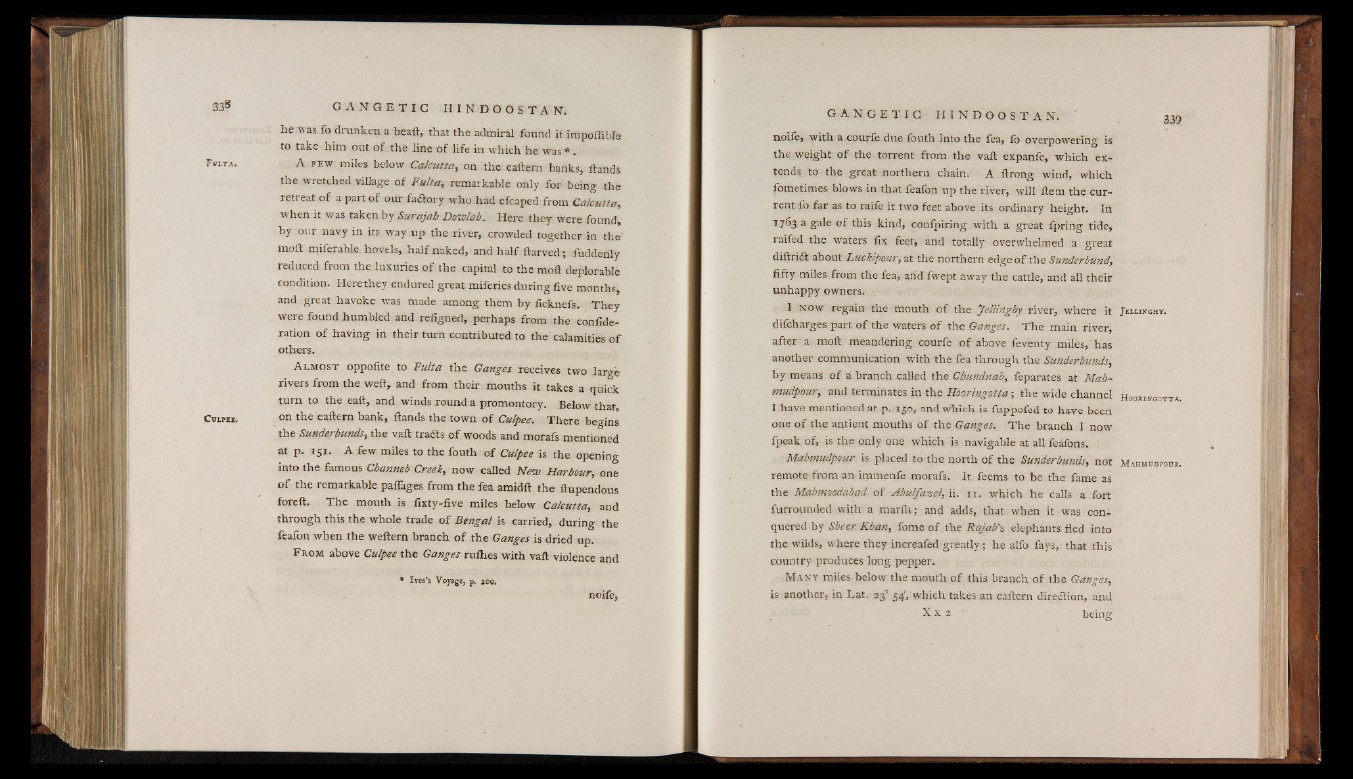
F b l t a .
CviFEE.
he was, fo drunken a beaft, that the admiral found it impoflibfe
to take him out o f the line of life in which he was * .
A f e w miles below Calcutta, on the eaftern banks, Hands
the wretched village of Fulta, remarkable only for being the
retreat of a part o f our facftory who had efcaped from Calcutta,
when it was taken by Surajab Dowlab. Here they were found,
by our navy in its way up the river, crowded together in the*
moft miferable hovels,, half naked, and half ftarved; fuddenly
reduced from the.luxuries o f the capital to the moft deplorable
condition. Herethey endured great miferies during five months,
and great havoke was made among them by ficknefs. They
were found humbled and refigned, perhaps from the confide-
ration of having in their turn contributed to the calamities of
others.
A lm o s t oppofite to Fulta the Ganges receives two large
rivers from the weft, and from their mouths it takes a quick
turn to the eaft, and winds round a promontory. Below that
on the eaftern bank, ftands the town of Culpee. There begins
the Sunderbunds, the vaft traits o f woods and morafs mentioned
at p. 151. A few miles to the fouth of Culpee is the opening
into the famous Cbanneb Creek, now called New Harbour, one
o f the remarkable pafiages from the fea amidft the ftupendous
foreft. The mouth is fixty-five miles below Calcutta, and
through this the whole trade o f Bengal is carried, during the
feafon when the weftern branch o f the Ganges is dried up.
F rom above Culpee the Ganges ruihes with vaft violence and
* Ives’s Voyage, p. 100.
noife,
noife, with a courfe due iouth into the fea, lo overpowering is
the weight of the torrent from the vaft expanfe, which extends
to the great northern chain. A ftrong wind, which
fometimes blows in that feafon up the river, will item the current
fo far as to raife it two feet above its ordinary height. In
1763 a gale of this kind, confpiring with a great fpring tide,
raifed the waters fix feet, and totally overwhelmed a great
diftridt about Luckipour, at the northern edge o f the Sunderbund,
fifty miles from the fea, arid fwept away the cattle, and all their
unhappy owners.
1 n o w regain the mouth o f the Jellingby river, where it Jelhnghy.
difeharges part o f the waters of the Ganges. The main river,
after a moft meandering courfe of above feventy miles, has
another communication with the fea through the Sunderbunds,
by means of a branch called the Chundnah, feparates at Mah-
mudpour, and terminates in the Hóoringotta; the wide channel hoorikgotta.
I have mentioned at p. 130, and which is fuppofed to have been
one of the antient mouths of the Ganges. The branch I now
fpeak of, is the only one which is navigable at all feáfons.
Mahmudpour is placed to the north of the Sunderbunds, not M a h m u d f o v r .
remote from an immenfe morafs. It feems to be the fame as
the Mabmoodabad of Abulfazel, ii. 11. which he calls a fort
furrounded with a mar fit; and adds, that when it was conquered
by Sheer Khan, fome of the Rajah's elephants fled into
the wilds, where they increafed greatly; he alfo fays, that this
country produces long pepper.
Many miles below the mouth o f this branch o f the Ganges,
is another, in Lat. 230 34', which takes an eaftern dire¿tion, and
X x 2 being